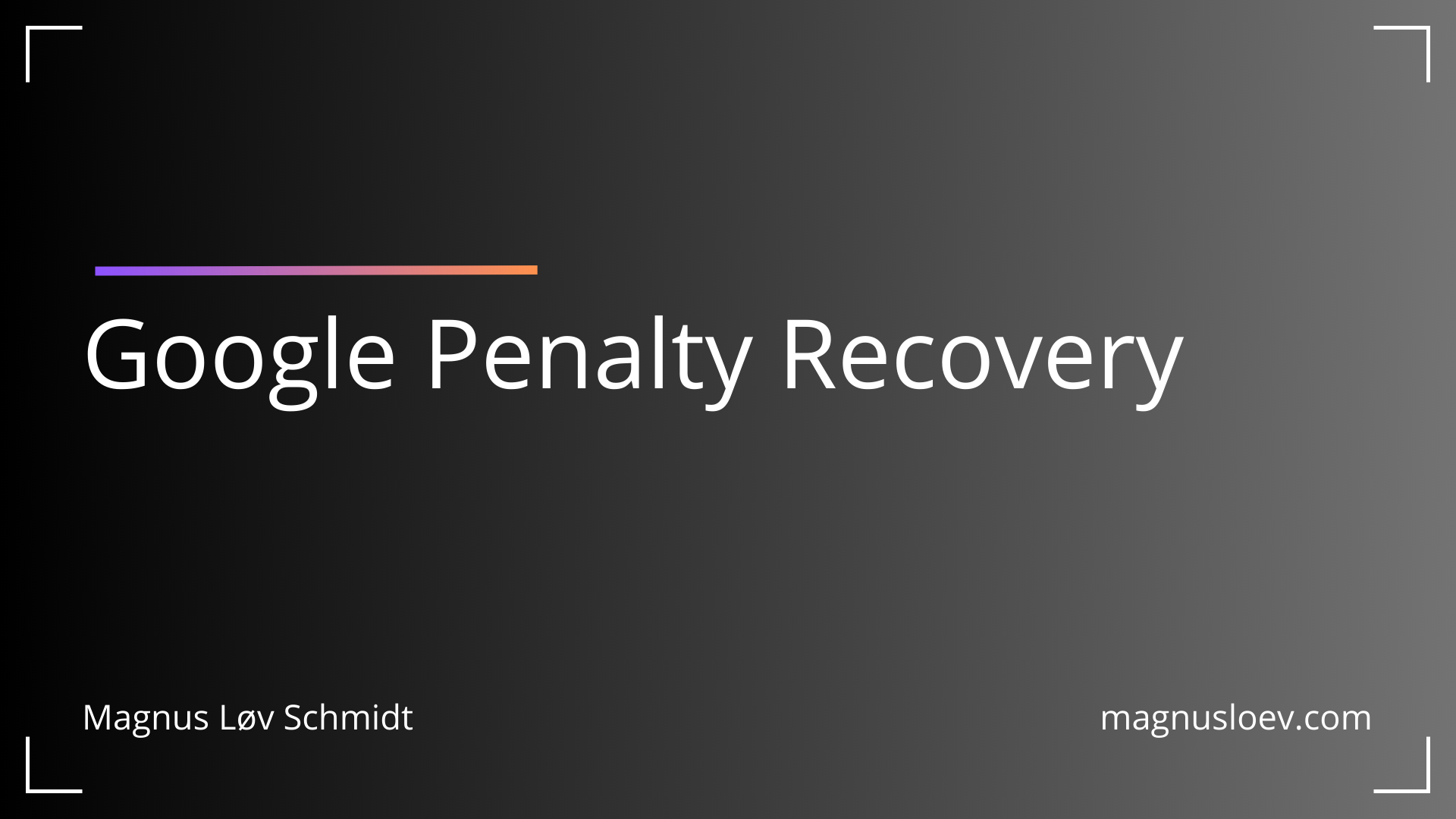So You've Been Penalized (Congratulations!)
Ah, the Google penalty. That magical moment when you log into Analytics and discover your traffic chart looking like it just jumped off a cliff without a parachute. One day you're crushing it in the SERPs, the next you're buried deeper than my childhood dreams of becoming a professional athlete.
Welcome to the penalty club! It's a surprisingly crowded place filled with SEO "experts" who swore that buying 10,000 links from a guy in a Facebook group for $50 was totally white-hat. Who could have possibly seen this coming? Only everyone. Literally everyone.
But don't worry! Recovery is possible. Well, "possible" in the same way that winning the lottery is possible. It happens to someone, somewhere, occasionally. And hey, it could be you if you follow this guide instead of repeating whatever brilliant strategy landed you here in the first place.
Before we dive in, let's set realistic expectations: recovery isn't instant. Shocking, I know. Turns out, once Google decides you're a rule-breaking miscreant, they don't immediately forgive you after a half-hearted apology. Who'd have thought?
Types of Google Penalties (Choose Your Poison)
Google has thoughtfully provided multiple ways to tank your website. How considerate! Let's explore your specific flavor of digital punishment.
Manual Actions (AKA The Walk of Shame)
Manual actions occur when an actual human at Google looks at your site and thinks, "Wow, this is garbage." It's like getting a speeding ticket, except instead of a fine, your business model implodes.
The "good" news? Google actually tells you what you did wrong. How generous! It's like an arsonist explaining exactly how they burned your house down while you stand in the smoldering ruins.
Common manual penalties include:
- Unnatural links to your site: Remember all those amazing backlinks you bought? Google remembers too.
- Thin content: Turns out those 300-word articles you paid $5 each for aren't exactly the Pulitzer-worthy content Google was hoping for.
- Pure spam: Congratulations! Your site is so bad it falls into Google's "just throw the whole thing away" category.
- Hidden text or keyword stuffing: Your clever trick of putting white text on a white background? Yeah, Google invented computers. They can see that.
Algorithmic Penalties (Mystery Fun Box Edition)
Unlike manual penalties, algorithmic penalties happen automatically and come with no notification whatsoever. It's Google's version of ghosting you after a three-year relationship.
Major algorithm culprits include:
- Panda: For when your content is so thin it makes supermodels look obese.
- Penguin: Because your backlink profile looks like it was assembled by a drunk toddler with access to fiverr.com.
- Core Updates: Google's quarterly "let's completely rearrange the search results for no apparent reason" party.
The fun part about algorithmic penalties? You get to play detective and guess what you did wrong! It's like a murder mystery dinner, except the victim is your revenue stream.
How to Identify a Google Penalty (Besides the Obvious Crying)
Not sure if you've been penalized or if your SEO is just naturally terrible? Let's investigate!
Sudden Traffic Decline (AKA The SEO Heart Attack)
Your traffic chart should NOT look like the stock market during a financial crisis. If your visitors disappeared faster than free beer at an agency party, you're probably penalized.
When examining traffic patterns:
- A normal fluctuation is 10-15%. A penalty is when your CEO calls at 6 AM asking why the website isn't showing up anywhere.
- Check if the drop lines up with a known algorithm update, then pretend you anticipated this all along.
- Act shocked that the 50 PBN links you bought last month could possibly be related to this tragedy.
Ranking Freefall (From Hero to Zero)
One day you're proudly telling clients about your #1 rankings, the next you're on page 8 next to that weird site selling homemade squirrel repellent.
Use fancy tools to confirm what you already know: you're not ranking anymore. Then take screenshots to show your boss while explaining that "SEO is a long-term investment."
- Watch as your prized keywords now bring up your competitors instead
- Marvel as even your brand name starts showing "did you mean" suggestions
- Experience the thrill of explaining to clients why their investment is suddenly worthless
Search Console Warnings (Google's Passive-Aggressive Notes)
For manual penalties, Google kindly sends a notification that essentially says, "We've noticed you trying to cheat and we're not impressed."
Check these areas in Search Console:
- Manual Actions report (where Google lists all the ways you've disappointed them)
- Security Issues report (in case your penalty comes with bonus malware)
- Coverage reports (to see exactly which pages Google has deemed unworthy)
The notifications are written in that special tone that makes you feel like you're being scolded by a disappointed parent. Enjoy!
Google Penalty Recovery Process (Your Digital Walk of Atonement)
Ready to repent for your SEO sins? Let's start your journey back to Google's good graces, which is about as straightforward as assembling IKEA furniture while blindfolded.
1. The "Oh God, What Have I Done" Analysis Phase
Before fixing anything, you need to figure out exactly how badly you've screwed up. This is the SEO equivalent of sobering up after a wild night and checking your sent messages.
Start with a comprehensive audit:
- Technical SEO audit: Discover all the things your developer swore were "best practices"
- Content audit: Realize that those 500 auto-generated location pages might have been a bad idea
- Backlink audit: Confront the horror of your link profile that contains more spam than a Hawaiian cookbook
- Historical penalty check: Find out if your domain comes with bonus previous penalties, like buying a used car that turns out to be haunted
Document everything thoroughly, partly for your reconsideration request but mostly so you have evidence when you fire your previous SEO agency.
Tools for Analysis (Or How to Spend Even More Money After Losing All Your Traffic)
- Google Search Console (free, which will be important now that revenue has dried up)
- Screaming Frog (which will make you scream when you see what it uncovers)
- Semrush or Ahrefs (to see exactly how many competitors are now outranking you)
- Wayback Machine (to reminisce about when your site actually appeared in search results)
2. Link-Related Penalty Recovery (The Digital Walk of Shame)
If your analysis reveals that your backlink strategy was essentially "quantity over everything else," prepare for the humiliating process of link cleanup.
First, create a complete backlink inventory:
- Export all your links and realize just how many gambling and pharma sites are pointing to your respectable business
- Classify links on a scale from "questionable" to "good lord, what were we thinking?"
- Prioritize the worst offenders, which is usually most of them
The cleanup process follows this hierarchy:
- Direct removal: Send awkward emails to webmasters begging them to remove the links you previously begged them to add
- Disavow preparation: Tell Google which links you paid for but now want to pretend you had nothing to do with
- Documentation: Create a spreadsheet so detailed it would make an accountant weep with joy
Remember, Google loves to see you grovel. Make sure your reconsideration request has just the right mix of remorse, technical detail, and subtle groveling.
3. Content Quality Improvement (From Garbage to Slightly Less Garbage)
For content-related penalties, you'll need to admit that maybe, just maybe, those AI-generated articles spun from your competitors' content weren't such a brilliant idea.
Start by identifying problematic content:
- Thin content (where the meta description is longer than the actual page)
- Duplicate content (copying Amazon product descriptions wasn't the shortcut you thought it was)
- Keyword-stuffed pages that read like they were written by a SEO robot having a stroke
Then implement this exciting content strategy:
- Remove: Delete content so bad it makes YouTube comments look like Shakespeare
- Consolidate: Turn 50 terrible pages into 5 mediocre ones
- Improve: Hire actual writers instead of the cheapest freelancers on Upwork
- Redirect: Point removed content to pages that won't make Google cry
- Noindex: Hide your shame from search engines (but keep it for the three human visitors you still get)
Quality isn't just about word count—it's about not making users regret clicking on your search result. Each page should answer the question without making the reader want to throw their device out a window.
4. Technical SEO Fixes (Or: Undoing Everything Your Developer Thought Was Clever)
Even the best content can't save you if your site is a technical disaster zone.
Common technical factors in penalties include:
- Cloaking that was about as subtle as wearing a fake mustache to rob a bank
- Redirects that send users on a tour of every domain you've ever purchased
- Hidden text that was visible to Google but not users (spoiler: Google noticed)
- Mobile pages that look great on your iPhone 4 but nowhere else
Your technical recovery checklist should include:
- Fix server response codes (all those 404s aren't "building character," they're killing your site)
- Implement proper canonical tags (no, you can't have 12 versions of the same page)
- Make your site mobile-friendly (it's 2025, not 1998)
- Secure your site with HTTPS (padlocks aren't just for keeping your diary private)
Technical fixes are usually the least painful part of recovery—until your developer explains how long it will take and how much it will cost.
5. Reconsideration Request Process (The Art of Digital Begging)
For manual penalties, you'll need to submit a reconsideration request, which is essentially asking Google "pretty please with a cherry on top, can I be in search results again?"
A successful request includes:
- Acknowledgment: "Yes, I tried to cheat your system. My bad."
- Documentation: Exhaustive proof that you've reformed your evil ways
- Assurance: Promises that you'll never, ever do it again (until the next time you think you won't get caught)
- Evidence: Before/after screenshots that make your site transformation look like a home renovation show
- Humility: A tone that says "I have learned my lesson" rather than "this is totally unfair"
Many reconsideration requests fail because they read like a toddler explaining why it wasn't their fault they drew on the walls. Google doesn't care about your excuses—they want contrition and evidence.
When writing your request:
- Be concise but thorough (Google reviewers don't want to read your SEO manifesto)
- Include hard data ("I removed 3,421 spammy links" not "I removed many bad links")
- Explain how you'll prevent future violations (hint: "being less obvious about it" is not the right answer)
After submission, practice patience or heavy drinking, whichever helps you cope with the wait. Google typically responds within 2-4 weeks, though it will feel like centuries.
Real Recovery Case Study: A Tale of Redemption (Or: How I Stopped Worrying and Learned to Follow the Rules)
Want proof that recovery is possible? Here's a real story that's only slightly embellished for dramatic effect.
One of my clients came to me after their traffic dropped faster than Bitcoin after an Elon Musk tweet—73% overnight. Investigation revealed they had more toxic backlinks than a poisonous snake convention.
The Situation (AKA The SEO Crime Scene)
The client had previously hired an "SEO expert" who built links through:
- Private blog networks with names like "TopQualityBacklinksNotSpam.xyz"
- Comment spam that made YouTube comment sections look intellectual
- Article directories that hadn't been updated since Myspace was popular
- Exact-match anchor text so obvious it practically screamed "I'M MANIPULATING RANKINGS!"
Additionally, their product pages contained:
- Manufacturer descriptions copied verbatim from 50 other sites
- About three original words per page (usually just the company name)
- Keyword density that would make even 2005 SEOs blush
Google Search Console showed a manual action that basically said, "Everything about your site is terrible."
The Recovery Plan (Operation Digital Redemption)
We implemented a strategy that was less "quick fix" and more "total site overhaul":
- Link Cleanup:
- Identified 3,200 toxic backlinks (basically their entire profile)
- Successfully removed 1,850 through direct outreach and mild begging
- Disavowed the remaining 1,350 with a disavow file so large it needed its own zip code
- Documented every painful step in a spreadsheet that became my new personality
- Content Overhaul:
- Rewrote 1,500 product descriptions that actually described the products (revolutionary concept!)
- Added buying guides written by people who understood both English and the products
- Created in-depth resources that weren't just "keyword + buy our stuff"
- Improved on-page elements so they were less "2008 SEO guidebook" and more "actually helpful for users"
- Technical Fixes:
- Fixed redirects that were sending users on digital wild goose chases
- Implemented canonical tags to tell Google which version of the 17 duplicate pages they should index
- Made the site faster than a caffeinated cheetah (relatively speaking)
The Results (Yes, Miracles Occasionally Happen)
Recovery wasn't instant—turns out Google doesn't immediately trust sites that have been caught red-handed trying to game the system. Shocking!
- Week 4: Reconsideration request submitted (with enough documentation to fill the Library of Congress)
- Week 7: Manual action revoked (cue heavenly choir music)
- Week 10: Rankings began returning (starting with brand terms, because Google still had trust issues)
- Week 16: Traffic surpassed pre-penalty levels (plot twist!)
- Month 6: Revenue increased 34% compared to pre-penalty period (the client suddenly remembered my name)
The key insight? Sometimes a penalty is actually the universe's way of forcing you to fix your garbage website. By addressing both the symptoms (bad links) and the deeper issues (terrible content), the site emerged stronger—like SEO CrossFit, but with fewer insufferable Instagram posts.
Prevention Strategy: How to Not End Up in This Mess Again
Recovering from a penalty is about as fun as a root canal performed by an art student. Prevention is much easier.
Implement these measures to keep your site penalty-proof:
Regular Audit Schedule (Trust Issues are Good in SEO)
Prevention requires vigilance and a healthy dose of paranoia:
- Weekly: Check Search Console like you check your ex's Instagram
- Monthly: Review new backlinks to ensure no one's sabotaging you (or you're not sabotaging yourself)
- Quarterly: Conduct technical audits to catch issues before Google does
- Bi-annually: Evaluate content quality with the critical eye of a disappointed parent
These checks are like flossing—boring, sometimes painful, but much better than the alternative.
Risk Assessment for SEO Tactics (The "Would This Get Me Banned?" Test)
Before implementing any SEO strategy, run it through this sophisticated risk assessment tool called "common sense":
- If the tactic has "hack," "loophole," or "Google doesn't want you to know" in its description, maybe skip it
- If it promises results that seem too good to be true, they are
- If you wouldn't tell a Google employee about it at a conference, it's probably against guidelines
- If it costs $5 and comes from a guy named SEOMaster69, just... no
Remember: that incredible "secret technique" being sold in Facebook groups is secret for a reason—it's either against guidelines or doesn't actually work.
- Avoid anyone guaranteeing rankings (unless they're guaranteeing they'll tank)
- Be skeptical of services offering 1,000 links for $50 (that's 5 cents per future headache)
- Question tactics that focus on algorithms instead of users (Google's getting smarter, you're not)
What worked in 2015 might get you banished to search result Siberia today. The SEO tactic graveyard is full of once-popular techniques.
Documentation and Training (Or: Stop Letting Kevin from Accounting Update the Website)
Often, penalties occur because someone in your organization decided to "try this cool SEO thing I read about":
- Create an SEO policy document that essentially says "consult the SEO person before doing anything"
- Train your team on what not to do (the list is longer than you think)
- Establish approval processes so Dave from HR can't randomly add 300 footer links
- Document everything so when things go wrong, you know exactly who to blame
Many penalties stem from decisions made by well-meaning staff who thought buying links from that nice man who emailed them was helping.
Life After Penalty (Yes, It Exists)
Google penalties, while devastating, don't have to be a death sentence for your website. With the right approach, enough groveling, and a complete website overhaul, you can recover and maybe even come out stronger on the other side.
Remember these key principles:
- Act quickly but thoroughly. The longer you stay in Google's penalty box, the harder it is to convince them you've reformed.
- Fix the real problems, not just the symptoms. Don't just remove bad links—stop being the kind of marketer who buys them.
- Document everything. Partly for Google, mostly so you have evidence when the blame game starts.
- Focus on users instead of algorithms. Crazy concept: make a site people actually want to visit!
- Stay updated on guidelines. What was fine yesterday might be penalty-worthy today, because Google enjoys moving the goalposts mid-game.
Recovery requires patience, persistence, and possibly a therapeutic hobby to manage the stress. You might not see immediate results, but consistent effort will eventually restore your site—just in time for the next algorithm update to mess it all up again.
The ultimate goal isn't just recovery—it's building a site so aligned with Google's guidelines that you can sleep at night without nightmares of manual actions. By focusing on quality and user experience instead of shortcuts, you create sustainable SEO success that can weather Google's ever-changing standards.
Or you could just run Google Ads and skip all this drama. Your call.




Comments